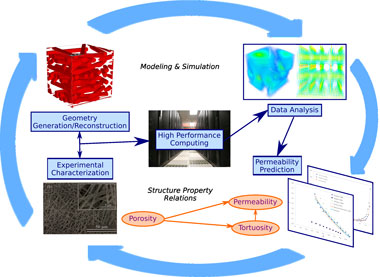Crossref Citations
This article has been cited by the following publications. This list is generated based on data provided by
Crossref.
Tallarek, Ulrich
Hlushkou, Dzmitry
Rybka, Julia
and
Höltzel, Alexandra
2019.
Multiscale Simulation of Diffusion in Porous Media: From Interfacial Dynamics to Hierarchical Porosity.
The Journal of Physical Chemistry C,
Vol. 123,
Issue. 24,
p.
15099.
Silva, Goncalo
and
Ginzburg, Irina
2020.
Reviving the local second-order boundary approach within the two-relaxation-time lattice Boltzmann modelling.
Philosophical Transactions of the Royal Society A: Mathematical, Physical and Engineering Sciences,
Vol. 378,
Issue. 2175,
p.
20190404.
Wang, Fang
Kumari, Suman
and
Schiller, Ulf D.
2020.
Computational characterization of nonwoven fibrous media. II. Analysis of microstructure effects on permeability and tortuosity.
Physical Review Materials,
Vol. 4,
Issue. 8,
Xu, Jie
Liu, Yin
Li, Jiaqin
Shen, Wenhao
and
Corriou, Jean-Pierre
2022.
Statistical Reconstruction of 3D Paper Structure Using Simulated Annealing Algorithm Based on 2D Scanning Electron Microscopy Image.
Journal of Natural Fibers,
Vol. 19,
Issue. 16,
p.
13815.
Lee, Gi Wook
Chun, Byoungjin
and
Jung, Hyun Wook
2023.
Lattice Boltzmann modeling and analysis of ceramic filtration with different pore structures.
Korean Journal of Chemical Engineering,
Vol. 40,
Issue. 6,
p.
1309.
Pietrzyk, Kyle
and
Battiato, Ilenia
2023.
Automated Symbolic Upscaling: 1. Model Generation for Extended Applicability Regimes.
Water Resources Research,
Vol. 59,
Issue. 7,
Wittstock, Gunther
Bäumer, Marcus
Dononelli, Wilke
Klüner, Thorsten
Lührs, Lukas
Mahr, Christoph
Moskaleva, Lyudmila V.
Oezaslan, Mehtap
Risse, Thomas
Rosenauer, Andreas
Staubitz, Anne
Weissmüller, Jörg
and
Wittstock, Arne
2023.
Nanoporous Gold: From Structure Evolution to Functional Properties in Catalysis and Electrochemistry.
Chemical Reviews,
Vol. 123,
Issue. 10,
p.
6716.
Wlodarczyk, Jakub K.
Schärer, Roman P.
Friedrich, K. Andreas
and
Schumacher, Jürgen O.
2024.
Upscaling of Reactive Mass Transport through Porous Electrodes in Aqueous Flow Batteries.
Journal of The Electrochemical Society,
Vol. 171,
Issue. 2,
p.
020544.
Ramirez-Velez, Alejandro
Rodriguez-Cardona, Carolina
and
Restrepo-Villegas, Estephania
2024.
DIGITAL IMAGES ANALYSIS AND QUANTITATIVE STRUCTURE-PERMEABILITY RELATIONSHIPS
.
Journal of Porous Media,
Vol. 27,
Issue. 6,
p.
45.
Mustapa, Siti Aisyah Syaerah
Woon, Kai Lin
Zakaria, Muhammad Zhafran
and
Lee, Vannajan Sanghiran
2025.
Impact of solvent environment on π–π interactions between the tert-butyl-TPA donor and the TRZ acceptor.
Journal of Molecular Liquids,
Vol. 418,
Issue. ,
p.
126723.
